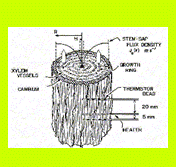

|
Tranzflo NZ Ltd |


|
Specialists in Sap Flow Sensors |
|
Calibration of heat-pulse methods |
|
Tranzflo NZ Ltd, 15 Parata St, Palmerston North 4410, NEW ZEALAND Tel: +64-6-357-4600 Fax: +64-6-357-4601 E-mail: stevegreen@inspire.co.nz |
|
Calculations of VZ and VM assume that the heater and temperature probes have no effect on the measured heat flow. In reality, convection of the heat-pulse is disturbed by the presence of the heater and temperature probes, and by the disruption of xylem tissue associated with their placement. These perturbations produce a systematic underestimation in the measured heat-pulse velocity (Cohen et al., 1981; Green and Clothier, 1988). Consequently, the heat-pulse velocity must be corrected for any probe-induced effects of wounding. This correction can either be done empirically (e.g. Cohen et al., 1981), or it can be based on physical principals, using an equation of the form:
where V [m s-1] is the corrected heat-pulse velocity and VH is the raw heat-pulse velocity that has been calculated using either Eq. [4] or Eq. [5].
Green et al (2003) presented a set of correction factors to account for the combined influence of sensor thermal properties and the subsequent blockage of sap streams. Our correction factors were computed using a numerical solution to Eq. [2]. The scientific paper can be downloaded by clicking here
The calibration model uses a finite difference form of Eq. 2 that is solved using an alternating-direction-implicit scheme in two dimensions (von Rosenberg, 1969). The numerical grid is set at 80.0 by 40.0 mm, with a spatial resolution of 0.1 mm, and the time step is set at 0.1 s. Thermal properties of the sapwood are taken from the data of Siau (1971) and Dunlap (1912), and thermal properties of the sensors are derived from data in Carslaw and Jaeger (1959). A ‘zero flow’ condition is assumed to occur within the wound width that exists in line with the sensors and parallel to the flow direction. The combined effect of stem moisture content, probe placement, and the wound-width are simulated over a range of sap flows. A set of correction coefficients (ai’s) is then determined from the ratio of the measured heat-pulse velocity to that ‘imposed’ across the model flow domain.
|
|
To contact us: |


